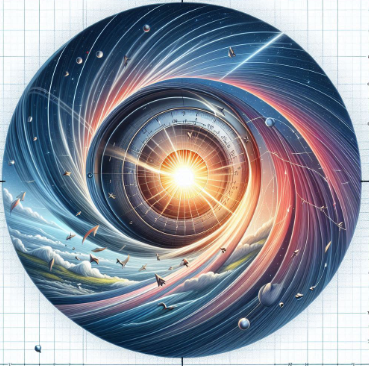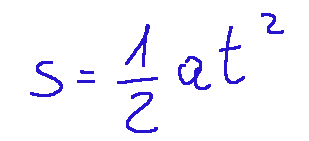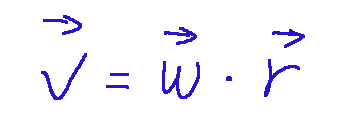
~~~ La versione in italiano inizia subito dopo la versione in inglese ~~~
ENGLISH

07-04-2025 - Physics - Motion [EN]-[IT]
With this post I would like to give a brief instruction about the topic mentioned in the subject
(code notes: X_84-83)
Motion

image created with artificial intelligence, the software used is Microsoft Copilot
Introduction
One of the bases of mechanics is motion.
In physics, motion refers to the change in the position of a body with respect to a reference system over time. They can be of various types.
Below is a classification of motions:
-Rectilinear motion
-Curvilinear motion
-Periodic motion
-Harmonic motion
Motion is described through the laws of kinematics, using scalar and vector quantities:
-Velocity
-Acceleration
-Trajectory
Velocity is the speed with which a body changes position, acceleration is the change in velocity over time and trajectory is the line described by the moving body.
Exercise
Description
A plane, initially stationary, starts and moves with constant acceleration. In 10 seconds it travels 300 meters. What is the distance it travels in 20 seconds?
Execution
Reading the exercise we can make the following considerations:
-The plane starts from rest so it will have an initial speed v0 = 0
-The acceleration is constant
-In 10 s it travels 300 m
In this case we can use the formula for uniformly accelerated motion, that is the following.

In our case however we have that v0, that is the initial speed is equal to zero.
So we can rewrite the formula above in a simplified way, like this:

From this formula we know s and t:
-s=300m
-t=10s
Let's rewrite the formula by making the substitutions.

the acceleration will be

Now that we know the acceleration, let's always go back to the formula expressed before with t=20s:

Result
1200m
Curvilinear motions
Curvilinear motions are motions that have a trajectory on a curved line. It can be a circle or a parabola.
The main curvilinear motions are:
The uniform circular motion where the trajectory is a circumference and the constant speed.
The variable circular motion where the trajectory is a circumference and the variable speed.
Parabolic motion where the trajectory is a parabola as in the motion of a projectile.
Curvilinear motions are more complex than rectilinear motions because for velocity and acceleration their tangential and normal components to the direction of motion should also be analyzed.
Uniform circular motion
Uniform circular motion can be described by two different time laws, one relating to the displacement on the circumference and the other relating to the angle described.
Time law relative to the circumference:

Time law relative to the angle:

The angular velocity
Where ω represents the angular velocity, or the variation of the angle θ over time. ω is also defined as pulsation. Since the motion is uniform, the angular velocity is also constant.

from the previous relation we obtain that:

In uniform circular motion it is possible to express the
velocity and acceleration in vector terms.

Conclusions
In physics, motion refers to the change in position of a body with respect to a reference system over time and is certainly one of the fundamental concepts of mechanics.
Question
The hands of a clock follow a circular path around the dial, did you know that the movement of the hands of a clock are an example of uniform circular motion in everyday life?

ITALIAN

07-04-2025 - Fisica - Il moto [EN]-[IT]
Con questo post vorrei dare una breve istruzione a riguardo dell’argomento citato in oggetto
(code notes: X_84-83)
Il moto

immagine creata con l’intelligenza artificiale, il software usato è Microsoft Copilot
Introduzione
Una delle basi della meccanica è il moto.
In fisica, il moto si riferisce al cambiamento della posizione di un corpo rispetto a un sistema di riferimento nel corso del tempo. Essi possono essere di vario tipo.
Qui di seguito una classificazione dei moti:
-Moto rettilineo
-Moto curvilineo
-Moto periodico
-Moto armonico
Il moto viene descritto attraverso le leggi della cinematica, utilizzando grandezze scalari e vettoriali:
-Velocità
-Accelerazione
-Traiettoria
La velocità è la rapidità con cui un corpo cambia posizione, l'accelerazione è il cambiamento della velocità nel tempo e la traiettoria è la linea descritta dal corpo in movimento.
Esercizio
Descrizioe
Un aereo, inizialmente fermo, parte e si muove con accelerazione costante. In 10 secondi percorre 300 metri. Qual è lo spazio che percorre in 20 secondi?
Svolgimento
Leggendo l'esercizio possiamo fare le seguenti considerazioni:
-L'aereo parte da fermo quindi avrà una velocità iniziale v0 = 0
-L'accelerazione è costante
-In 10 s percorre 300 m
In questo caso possiamo usare la formula del moto uniformemente accelerato, cioè la seguente.

Nel nostro caso però abbiamo che v0, cioè la velocità iniziale è uguale a zero.
Quindi possiamo riscrivere la formula sopra in maniera semplificata, come quella che segue:

Di questa formula conosciamo s e t:
-s=300m
-t=10s
Riscriviamo la formula facendo le sostituzioni.

l'accelerazione sarà

Ora che conosciamo l’accelerazione, riprendiamo sempre in mano la formula espressa prima con t=20s:

Risultato
1200m
Moti curvilinei
I moti curvilinei sono moti che hanno una traiettoria su una linea curva. Può trattarsi di un cerchio o una parabola.
I principali moti curvilinei sono:
Il moto circolare uniforme dove la traiettoria è una circonferenza e la velocità costante.
Il moto circolare vario dove la traiettoria è una circonferenza e la velocità variabile.
Il moto parabolico dove la traiettoria è una parabola come nel moto del proiettile.
I moti curvilinei sono più complessi dei moti rettilinei in quanto per la velocità e l'accelerazione andrebbero analizzate anche le loro componenti tangenziali e normali alla direzione del moto.
Il moto circolare uniforme
Il moto circolare uniforme può essere descritto da due differenti leggi orarie, una relativa allo spostamento sulla circonferenza e l’altra relativa all’angolo descritto.
Legge oraria relativa alla circonferenza:

Legge oraria relativa all’angolo:

La velocità angolare
Dove ω rappresenta la velocità angolare, ovvero la variazione dell'angolo θ nel tempo. ω è definita anche come pulsazione. Essendo il moto uniforme, anche la velocità angolare è costante.

dalla relazione precedente si ricava che:

Nel moto circolare uniforme è possibile esprimere la
velocità e l’accelerazione in termini vettoriali.

Conclusioni
In fisica, il moto si riferisce al cambiamento di posizione di un corpo rispetto a un sistema di riferimento nel corso del tempo ed è certamente uno dei concetti fondamentali della meccanica.
Domanda
Le lancette dell'orologio seguono una traiettoria circolare attorno al quadrante, lo sapevate che il movimento delle lancette di un orologio dell'orologio sono un esempio di moto circolare uniforme nella vita quotidiana?
THE END